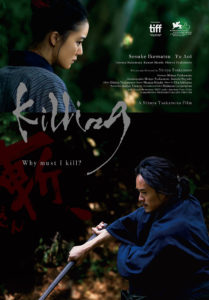Director: Shinya Tsukamoto
Writer: Shinya Tsukamoto
Cast: Yu Aoi, Sosuke Ikematsu, Kohji Katoh, Tatsuya Nakamura, Ryusei Maeda
Running Time: 80 min.
By Martin Sandison
I think I was the tender age of 14 when I first saw Shinya Tsukamoto’s Tetsuo. At that point I had seen David Lynch’s Eraserhead, and the two really went hand in hand for me. Both share an otherworldly, DIY, black and white aesthetic, and push boundaries in terms of nightmarish vision and filmmaking uniqueness. The world Tsukamoto created with Tetsuo was one that fully immersed me in the extremity of both its body horror content, strangely beautiful industrial soundtrack and anarchic visual style. I have always looked out for him as a filmmaker since then, and love Tetsuo 2, but for me he never got as good as the original. In fact, some of his later films lack much of anything to recommend them for. So it was with trepidation that I sat down to take in his most recent offering, the Samurai film, Killing. Happily, the film explores the genre in a way only Tsukamoto could, with a bold freshness to the aesthetic approach and resonating characters and performances.
The film begins with Ronin (a masterless Samurai) Mokunoshin (Kohji Katoh, Manhunt) teaching Ichisuke (Ryusei Maeda), a young boy, the ways of Bushido, and lodging at the families farm. The daughter Yu (Yu Aoi, Rurouni Kenshin) has a crush on the young man, following him around. One day the three witness a duel involving an ageing Ronin Sawamura (Tsukamoto), and he asks to recruit Mokunoshin to join him to take part in a raid on Edo, the ancient capital of Japan. Mokunoshin accepts, but what follows involving a rag tag group of outlaws and the farmers sees Mokunoshin question his sanity and ability to kill.
The opening of Killing is vintage Tsuakamoto in style, with a hand held camera constantly moving and some jarring cuts as Mokunoshin and Ichisuke face off with wooden swords. Other reviews I’ve read of this film complained that the action was hard to visualise because of this, for me Tsuakamoto’s approach injects originality in to the way to film traditional Samurai fights. As the film progresses, the fights become more interesting, with the two still facing off with wooden swords, leaving room for flowing camerawork and long takes. The only real proper sword fight in the movie hits hard and emotively, as Sawamura takes on the outlaws. The resonance of movies like the Lone Wolf and Cub series here is powerful; Tsukamoto combines this with his own style, a chaotic assemblage of cuts, blood sprays and intense close in angles.
In some other Tsukamoto’s movies I was put off by the way he incorporates over the top surrealism, to the point of exasperation. Even moments in the two Tetsuo films encourage this reaction. Also images in Tokyo Fist of extreme violence but played in a comic manner went too far for me, despite the bravura he shows as a filmmaker. In Killing there is an honourable, meditative restraint, honouring the genre he is working in, but still his style is vital. The use of jump cuts especially had me in raptures, within normal dramatic scenes especially. They add a spice to the visual mix, and trust him to still be experimenting, and pulling off, such little gems that add to the drama. In this way the characters are well drawn and understanding their motivations and the resolution of their arcs is deep and interesting.
Kohji really proves his worth with a nuanced performance, capturing the conflicts within that Mokunoshin is experiencing. He is a gifted, skilled swordsman, but cannot kill. Fear, and a strange moral compass together with his indecision about leaving for Edo due to his feelings for Yu, drive him to a breakdown. One scene wherein he unrestrainedly confronts Sawamura and begs him to tell him how to kill is remarkable in its emotional outpouring. Tsukamoto plays his role in a measured, internal way, and moves with grace and purpose, his face betraying more and more emotion as the film goes on. Yu Aoi does well with an underwritten part, but there are a couple of scenes that elliptically convey the spiritual point of the film, with beautiful compositions of her experiencing the harmony of nature. There is a peace and consciousness to her point of view, communicating the futility of violence and counterpointing Kohji and Tsukamoto’s differing extremities of emotion and madness due to living the life of a Samurai.
Killing falls short of true greatness due to a lack of that special something, that undefinable thing that makes the best movies, like Tetsuo, shine so brightly and change the game. As a worthy, certainly unusual and unique entry in to an age-old genre, it is worth many viewers time, and if you’re a fan of Tsukamoto you should definitely check the film out. In fact, I would put it in my top three of his movies. The final scene lingers long in the memory, and the film reminds us that there is still life in one of the greatest genres in all of cinema.
Martin Sandison’s Rating: 8/10




Hey, where did you see this? Is it out in North America anywhere?
Hey Hank, I saw it at the Glasgow Film Festival in Scotland. I’m unsure if it will have a cinema release, but should be out otherwise soon.